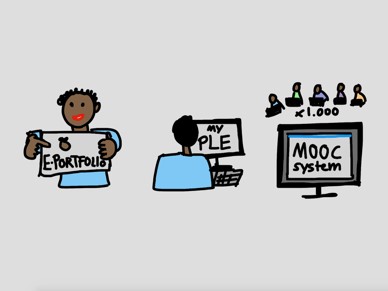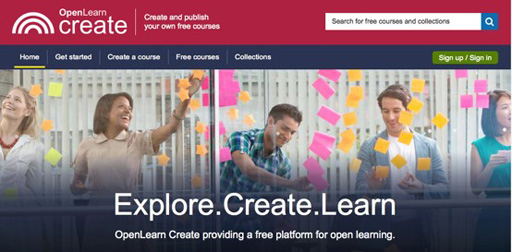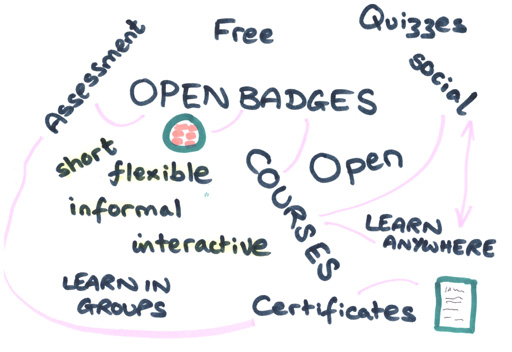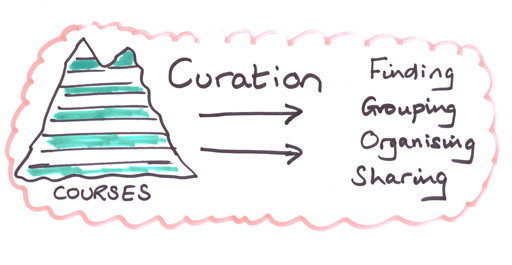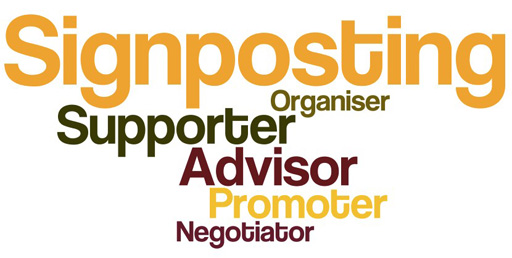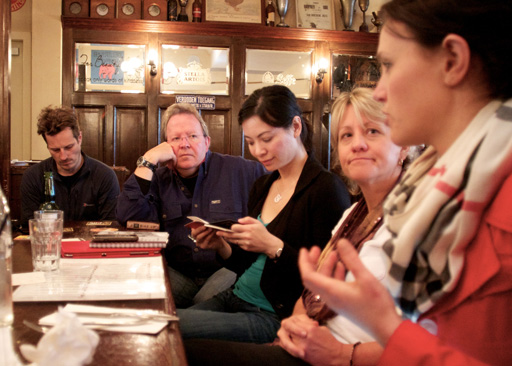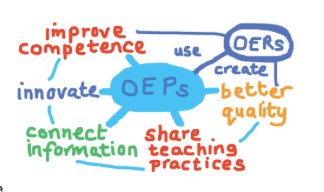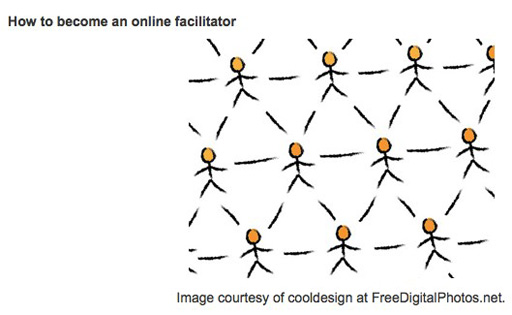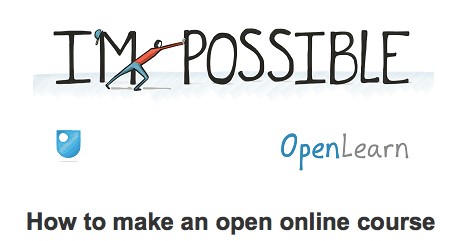Use 'Print preview' to check the number of pages and printer settings.
Print functionality varies between browsers.
Printable page generated Sunday, 23 November 2025, 1:01 AM
Supporting collective learning in workplace and community settings
Introduction
There is a huge amount of free learning material available on the internet but the sheer quantity of resources available can be overwhelming. Some people we have worked with have described looking for online courses as like entering a vast library without a map or a catalogue of the books. Exciting but scary, difficult to engage with and know where to start. In this course, we hope to give you some ideas about how to help potential learners find their way. We will concentrate on starting places and pathways that support people new to online study or returning to any form of study after a break.
The free online courses we will introduce you to in this course are short, typically in the range of between 5 and 25 hours total study time. Learners who successfully complete one of these courses may receive a certificate or a digital badge (more on badges in section 1.3).
Free online courses are different from the formal accredited courses that you might study at school, college or university. Accredited courses allow you to accumulate credit points, which can count towards formal qualifications. One credit point is equivalent to ten hours of study and the modules that make up formal qualifications are usually in the range from ten to sixty credits. So short, informal online courses represent a smaller time commitment and in most cases don’t directly lead to credit. However, they can provide an excellent stepping-stone to full-time study.
Learning is very personal and many adults have had experiences that dent their confidence. Often they don’t value their life experience or all the things they have learnt outside the formal education system. At the same time, they may believe that only certain kinds of classroom and teacher led environments are valid forms of learning. In this course you will tackle these misapprehensions and develop some simple models for helping adult learners support each other, build their confidence and develop skills that enable them to move on to more formal learning should they choose to do so.
The course is in two parts. In the first we look at how to find and choose appropriate online courses. In the second we develop some basic ideas of how to organise group learning.
This course has been developed in Scotland by the Opening Educational Practices in Scotland team and draws on insights and good practice from a wide range of partners. We held a number of workshops with Scottish Union Learning and we are particularly grateful to them and the Union Learning Representatives who attended workshops for their ideas. We have also drawn ideas and inspiration from initiatives to support Open Learning Champions in workplace and community settings developed by the Open University in Wales and Scotland.
Learning outcomes
By the end of this course:
You will have had an opportunity to reflect on your role in encouraging collective learning.
You will be more confident in finding free online courses that are relevant to your learners.
You will have explored some simple models for supporting individuals and groups in the workplace or community group.
You will have developed ideas on how to organise collective learning in your workplace or community group.
You will be familiar with some of the choices available to learners and the terminology that is used.
1 A new digital divide?
The term digital divide used to refer to lack of access to technology, particularly computers. Access remains an issue for some, but in the last few years there has been a huge increase in access to digital devices – laptops, tablets and smart phones. A new divide has developed around how people take advantage of the opportunities that these devices offer. For example, there has also been a rapid increase in the availability of free online courses that cover almost any topic you can think of. So far, these developments have tended to increase the choices open to those with experience of higher education and experience of learning online, but have not had a significant impact on those whose experience of the education system has been less positive or have been out of education for some time.
Activity 1
In your learning log, note down some of the reasons why your learners might feel reluctant to engage with online learning.
Discussion
Some of the reasons that we have heard include:
- A feeling that online means studying on your own and is therefore an isolated and unsupported experience
- Negative experience of the ‘tick box’ type online courses that are commonly used for mandatory workplace training
- A belief that the courses will be at too high a level
- Thinking that studying online will require digital skills that they don’t have
- Not having access to a computer or wifi at home
- Not having the time
- Experience of starting an online course but not completing
- Lack of familiarity or distrust of anything digital
Whatever the responses you listed to Activity 1 – these are real issues that need to be addressed. In the rest of this course we explore how.
1.1 Digital Participation
Until very recently many organisations concerned with adult education and lifelong learning were reluctant to embrace online learning because of the cost involved in learners getting access to laptop or desktop computers. This issue of equity has not completely gone away but the advent of tablets and smart phones and the increasing level of smart phone ownership has prompted a new approach. Free, online courses can now be accessed by a tablet or smart phone, as long as, you have an internet connection. In a short space of time, digital has become an ever present phenomenon in our lives. The question now is: how to support learners to develop the skills and confidence to thrive in this new digital world?
You might like to do a quick survey amongst friends and colleagues. How many of them use Google or YouTube on a regular basis? Have there been occasions when they’ve developed a new skill by watching a video or locating some frequently asked questions on the topic they were struggling to understand?
Our experience is that it’s hard to find people who never Google. It has become commonplace to use online platforms like Google and YouTube to check assumptions, ascertain facts and learn new skills. For most of us this type of self-directed learning is such a part of everyday life that we don’t even think of it as learning. It sits in a different place from being a student, taking a course or working for a qualification.
This is important because you can expect many of your learners to have some digital skills but they may not recognise the value of the skills they already have. It is also important to realise that digital skills used for online shopping or searching YouTube are a valuable base to start from, when improving digital online skills. They can then be extended and developed in new areas in order to become an effective learner.
1.2 Finding online courses
There are several sites that host free online courses and the huge range of free online courses that are available can be intimidating. In this section and in section 1.4 we will look at ways of making sense of all this choice.
Activity 2
One of the main UK sources of free online courses is OpenLearn, which is hosted by the Open University. You may have visited OpenLearn before, but in any case click on the link and spend a few minutes exploring the site. Note down how you feel about the site or, if you were already familiar with it, think about how it might seem to one of your learners.
Discussion
You may have mentioned:
- The sheer number of courses
- That the courses are at different levels
- It ‘looks like’ a university
- Lots of choice
- Navigation isn’t easy
- Courses for both leisure and work
- Where do you start?
We will be exploring OpenLearn in more detail later in the course and you should feel more confident navigating it by the end. OpenLearn is an example of a site hosting online courses that are free to access, and learners can study at their own pace. Let’s have a look at some of the other main sites, which use different models.
We have grouped them into three categories.
a) MOOC Platforms
MOOC is shorthand for Massive Open Online Course. The courses on these websites span a wide range of topics and levels but share a common look and feel. Each site will offer courses from a number of affiliated universities and specialist organisations. These sites are run as commercial operations but registration on courses is free. There may be charges for additional services, for example, end of course certificates. Typically courses have a start and finish date, although once you’ve registered it may be possible to access the materials beyond the end of the course. Course materials may be copyright. Examples of MOOC platforms include:
- FutureLearn: www.futurelearn.com which is UK based
- Coursera: www.coursera.org which is US based
- EdX: www.edx.org which is US based
b) Institutional ‘showcases’
Some universities make a point of offering a selection of their course content for free. Unlike MOOC platforms, materials are always available for study. Often the number of study hours is specified but you are free to organise when you start and when you finish. Resources are openly licensed, which means that you can use and reuse them, download, copy and modify (see section 1.5 for more information on this). Examples of institutional sites include:
OpenLearn – www.open.edu/ openlearn/ The Open University
open.ed – www.open.ed.ac.uk The University of Edinburgh
Open Spires – http://openspires.oucs.ox.ac.uk The University of Oxford
c) Open Platforms
These are sites that are provided for the use of anyone who has an open education project or a course to share. So courses you find on these sites may come from a variety of different providers and there may be differences in style and approach. Like the ‘showcase’ sites, these platforms also host openly licensed materials that may have no fixed start or finish dates. OpenLearn Create − www.open.edu/ openlearncreate/ − is one such site. It is also hosted by the Open University.
1.3 Things you should know about open
Open Badges
Open badges are free, digital records of achievement that you can save and share. All you need to set up an account, that enables you to store your badges, is an email address. If you are new to the idea of open badges and want to find out what they offer and how they differ from certificates, the Scottish Social Services Council open badges website is a great place to start.
Activity 3
Watch this short video from the Scottish Social Services Council, which explains about badges.
Open Licenses
An open license allows material to be copied, distributed, edited, remixed and built upon to make a new course. An open license can be applied to a complete course, but it can also be given to smaller pieces of material including text, images and videos. Find more about open licenses at https://creativecommons.org/ share-your-work/ licensing-considerations/ and Open licensing (in Becoming an open educator).
Educational material developed under an open license is sometimes known as an OER or Open Educational Resource.
1.4 Choosing courses
Your learners may have identified a particular area for study. In this case you may want to go directly to some of the sites mentioned in section 1.3 and search by subject or topic. Before you do this, however, you need to be clear about the level of experience the group members have and how familiar they are with online study. With this in mind as you search, you should ask yourself the following questions:
- Is it clear who produced the course – e.g. a college or university, a for-profit provider or a not-for-profit / third sector provider?
- How many study hours does the course involve?
- What educational level is the course at and is it suitable for my learners?
- Are there fixed start and finish dates or can the learners decide how long to take on their study?
- Is there assessment and a final certificate or badge and are these free or is there a charge?
Activity 4
Suppose that you have a small group of learners who are unconfident about maths and would like to try a basic course. Go to OpenLearn and see how many courses you find when you type maths in the search box. Check out the first two or three on the list and see how many of questions (a) to (e) you can answer.
- a.Is it clear who produced the course – e.g. a college or university, a for-profit provider or a not-for-profit provider?
- b.How many study hours does the course involve?
- c.What educational level is the course at and is it suitable for my learners?
- d.Are there fixed start and finish dates or can the learners decide how long to take on their study?
- e.Is there assessment and a final certificate or badge and are these free or is there a charge?
Searching is helpful but you may still worry that you’ve missed something. There’s a growing interest in ‘curation’; this is the process of searching through the courses that are on the web, finding material suitable for you learners, organising what you’ve found in ways that are meaningful in your context and sharing. There are some sites that make this job easier for you.
So, for example, on the OpenLearn site, free open courses that are designed for returners to study are grouped together. These introductory courses have a common structure, involve around 24 hours total study time and students who successfully complete a course can claim an open badge.
Another example of curation is an initiative developed by The Social Partnerships Network. The network is a group of eleven organisations, including the Open University, who have got together to create a suite of short vocational courses designed for returners to study. There are short videos to explain what is in involved in studying each course.
Each section of these courses is badged and the courses involve around 15 hours study in total.
Activity 5
Take a few minutes to explore the badged open courses offered on OpenLearn and the Social Partnerships courses on OpenLearn Create. Make a note of any that might be of interest to your learners in your learning log.
Another source of ideas about where to start is the Open Pathways to Higher Education guide, which has been developed by the Open University in Scotland to identify good starting places and possible routes between free, informal study and more formal qualifications.
1.5 Section Summary
You should now be aware of some of the places where you can find good quality free, open courses and be more confident about finding courses that are suitable for your learners. You will have reflected on some of the reasons why the prospect of online study can be daunting for potential learners and you should be able to explain to your learners some of the ways in which informal study of short online courses differs from formal study at college and university.
In section 2 consider this in more detail and explore how it’s possible to use online study resources to support group learning.
2 Learning in groups
Informal learning takes place in a myriad ways but almost always in social contexts where the learner learns from and with others. Despite this, because learning is also intensely personal, most prospective learners are both excited and nervous at the prospect of beginning a new course.
Almost everyone is familiar with the classroom model of learning where a teacher or tutor leads the development of the course. But other ways of organising learning are also valid. One model that has a long history is the study group. An example of a study group that most people will have heard about (even if they’ve never been involved with one) is the ‘book group’.
Activity 6
Pause for a moment to think about how book groups work and why they are popular.
Discussion
You might have noted that:
- In a book group everyone’s equal – there’s no expert or teacher
- Mostly the reading takes place elsewhere
- Members come together to discuss, ask questions and share ideas
- Each individual benefits from the shared experience of the whole group
- It is a social activity
You may have to convince your learners that the study group model works when the course material is an online course. The analogy with a book group is a strong one and we have found it helpful in convincing people. For our purposes the free online course takes the place of the book. It is a source of information, ideas and activities. The study group allows learners to come together to share, explore parts of the course they have found difficult; discuss, debate and give mutual support. In addition, they can support each other in developing the digital skills needed to learn effectively online.
It is important to stress that teacher-led groups and more informal, self-organised study groups have different strengths and weaknesses. It is not the case that one or the other is superior, both have their place.
2.1 The ‘facilitator’ role
In 2015, the OEPS project ran a series of workshops with Union Learning Representatives and asked them to think of a word that described their role in encouraging learning activity in their workplace. They mentioned:
Think about your own role - do any of these words fit for you?
One word that nobody in the workshops mentioned initially was facilitator. Certainly no one felt that they were in a tutoring or teaching role. If you work in a community setting, you might be more familiar with the term. In this section we will use ‘facilitator’ as a catch-all for the functions that you may see yourself performing in your role as a workplace or community educator.
A facilitator is someone who is trusted, an equal who is enthusiastic about opening up learning opportunities. They are not a teacher, a tutor, a computer geek or an expert on any particular course. They take action to signpost opportunities, bring people together in learning groups, support and encourage.
2.2 Getting started
Note that in this section and in what follows we are sharing ideas that others have found helpful. But you always need to think about the particular situation that you and your learners are in. Feel free to adapt and modify the suggestions in this course.
Setting up a study group requires a group of motivated individuals but there are many ways to get a group together.
Some facilitators conduct a short survey among potential learners. It is hard to choose without some idea of what is available, so you might want to identify a short list of relevant courses and topics and use the survey to gauge interest.
Sometimes you may be aware of a specific demand or need from an individual or a small group. In this case you might want to discuss with them informally and look together at some of the options highlighted in section 1. Once you have made a decision about what course to try it is always worth checking whether there are others who would like to join in.
Finally you might want to introduce the idea of using free online courses by running a short taster session.
Activity 7
Spend 5-10 minutes noting down in your learning log how you might run a taster session.
Discussion
There are many possibilities here:
If you or anyone else in your workplace or community has studied a short course on OpenLearn or one of the MOOC sites you could ask them to share their experience with the group.
Alternatively you could find a short piece of online material on something topical or of interest (OpenLearn has lots of material like this), and use it as a starter for a group discussion. Showing a short video or animation is ideal. Following a discussion of the topic you can then move on to discussing the idea of forming a study group to study a free online course.
In the next session we will explore ideas for running group sessions in more detail.
2.3 Setting up a group
Providing a structure within which learners can work together to support each other and share experience is at the core of this course. Forming effective groups is an important facilitation skill.
Activity 8
Think about a meeting or discussion that you were part of which left you feeling irritated or frustrated. Note down why you think you felt like this, in your learning log.
Discussion
You might have mentioned:
- One person dominated to the exclusion of others
- There was no clear agenda
- One item was allowed to run on and the agenda was never finished
- It was interesting but there was no clear plan for what happens next
Now turn these around, reflecting on those things that didn’t work in a group we can arrive at some sense of the things that help establish groups. If you are setting up a face-to-face meeting there are a number of simple things to keep in mind.
Be flexible about meeting times – try to find times and a place to meet that will work for everyone. You will need to think about some practical things. Can you find a place with internet access? Is it suitable for group discussion? It is good to avoid too much background noise and find somewhere where people can sit in a circle or round a table (a formal classroom set up can be intimidating and off-putting).
When you meet you will need to decide what you want to achieve in the time available, i.e. set an agenda. You may want to choose someone to chair/facilitate the meeting. The chair’s job is simply to:
- Keep an eye on the time so that you do get through your agenda
- Make sure that everyone gets a chance to speak
- Make sure that at the end of the meeting everyone knows what the next step is (for example, the arrangements for the next meeting)
Learning new things is exciting and scary. So it is really important to create an atmosphere in which everyone feels it is OK to ask questions. Simply formulating and asking a question can help both the person who is asking, and the rest of the group, to develop their thinking.
You may want to agree your own simple ground rules, for the group. To create an environment in which everyone can grow in confidence it is important that all the group members show respect for each other. This includes:
- Respecting each other’s ideas
- Not interrupting each other
- Everyone’s opinion counts
- Being honest with each other
2.4 Establishing a study group
Having one meeting is fine, but as probably became clear, when you reflected on groups that left you feeling annoyed or frustrated, keeping a group going can be challenging. Here we share some of things we and others have found work.
Once you have your group it is good to involve everybody in planning how you would like to organise yourselves. Here are some ideas you might find helpful.
- At the first meeting give everyone a chance to introduce themselves and to say something about what they hope to get out of the course. Encourage group members to talk about their apprehensions. Some group members may be concerned about their IT skills. Less experienced people might want to buddy up with someone who’s more confident.
- If there is someone in your workplace who has already studied the course you could ask them to say a few words about their experience and the impact it had on them.
- If the course has an introductory video you could watch it together.
- You might want to explain that just because the material is online it doesn't mean that you have to learn in isolation by sitting in front of a computer or a tablet on your own. The expectation is that group members will work through the materials in their own time. The study group is a place to work together, learn from each other and make the most of peer support. This is what we mean by good open educational practice. Peer support is really powerful. There is evidence that it increases personal satisfaction and makes it more likely that everyone will complete the course. At this first meeting, your main aim is to think through how you can make peer support work for you in your very specific circumstances?
Make sure that there’s plenty of time for activity. For example:
- If you have access to a computer, tablet or mobile phone, you could split into twos or threes and experiment with navigating your way around the course.
- Discuss how long you want to spend on the course and how often you intend to touch base with each other. This is the start of developing your own course structure. Remember, it is your structure and it is flexible but it is helpful to break down the course into smaller steps and targets.
- Depending on your circumstances, touching base can be a quick catch up at lunchtime or after work to share experiences and questions, or you could use social media. Facebook or WhatsApp, for example, allow you to set up a private group to keep in touch. Swapping mobile phone numbers and keeping up with a buddy by text and phone is really useful. Agree simple ground rules about how and when you’ll keep in touch.
- Look at the course structure. If it has several sections, as is usually the case, think about whether it’s possible to organise a group meeting or contact at the end of each section.
You almost certainly won’t do all of these things and you may have other ideas. But the key thing is to have a structure that pushes the group to keep in touch, talk to each other and make sure that no one feels that they are on their own.
End of course quiz
Having completed sections 1 and 2 you have covered all five of the course learning outcomes for this course. The end-of-course quiz prompts you to review your learning. If you score more than 60% correct responses on this quiz you are eligible to claim your digital badge.
Take the End-of-course quiz.
Next steps
Having completed this badged course you‘ll be keen to try out some of the ideas and get a study group established. However, do remember that this course is always available and you can drop into it at any time to refresh your ideas or find a link.
If you want to find out more about open education and open licensing then you might want to look at Becoming an Open Educator . This badged course is hosted on OpenLearn Create and is aimed at anyone who is curious about how free and open might change our approach to teaching and learning and has been designed for administrators, educators and facilitators in all sectors. It asks you to consider a range of questions. For example, how do I find open resources and what benefits might they bring? Does openness change the relationship to the content I create, the people I create content for, others with whom I share the material, and our own everyday practice and context? And if so, what impact, if any, does openness have on these practices and relationships?
If you’d like to extend your facilitation skills you could also try ‘How to become an online facilitator’ , which is also hosted on OpenLearn Create. While this course is for anybody who would like to become a facilitator on an online open course, it explores areas that are also relevant in face-to-face settings. You'll be introduced to concepts and ideas as how best to engage with learners, encourage conversation, and identify good practice for responding to learners online.
OpenLearn Create is an open site and anyone can apply to host an educational project on it. If you are interested in creating your own resources for learning or revising existing openly licenced material so that it works better for your learners then the site also hosts ‘How to make an open online course’ http://www.open.edu/ openlearncreate/ course/ view.php?id=2221, which will introduce you to the skills and knowledge that you need to design your own open online course.
And finally one of the best ways of gaining experience to share with your learners is to be an active online learner yourself. Why not try a course in a topic that you are interested in. If in doubt choose something that you’ll enjoy – learning should be an adventure not a chore!
Acknowledgements
This free course was written by Pete Cannell, with support from Anna Page, Rosemarie McIlwhan and Ronald Macintyre. It draws on ideas and experiences contributed by numerous individuals at workshops held by the Opening Educational Practices in Scotland project in 2015 and 2016.
Except for third party materials and otherwise stated (see terms and conditions), this content is made available under a Creative Commons Attribution-NonCommercial-ShareAlike 4.0 Licence.
Every effort has been made to contact copyright owners. If any have been inadvertently overlooked, the publishers will be pleased to make the necessary arrangements at the first opportunity.
Don't miss out
If reading this text has inspired you to learn more, you may be interested in joining the millions of people who discover our free learning resources and qualifications by visiting The Open University – www.open.edu/ openlearn/ free-courses.



